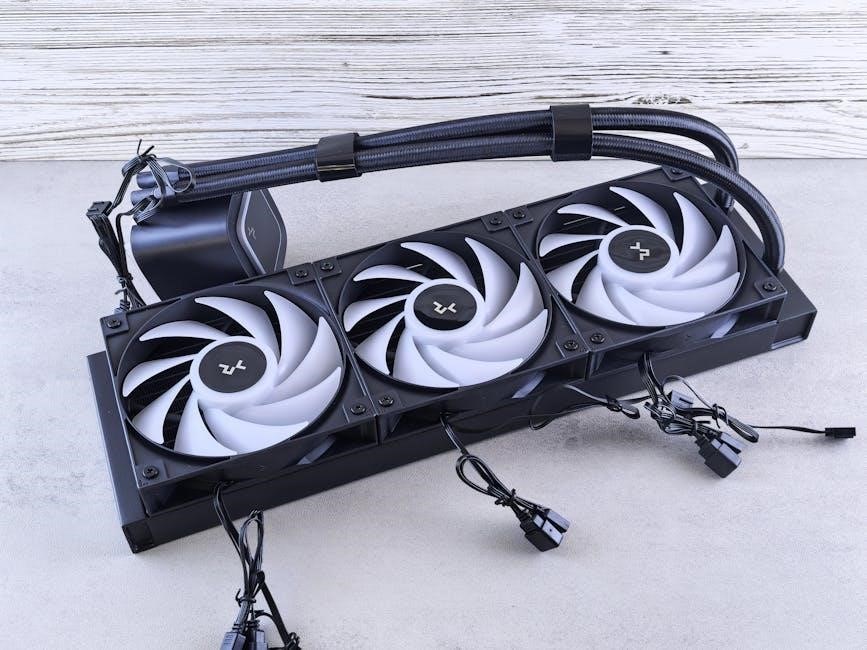The Weather Research and Forecasting (WRF) Model is a next-generation mesoscale numerical weather prediction system designed for both atmospheric research and operational forecasting. It supports versatile applications‚ from short-term weather forecasting to long-term climate simulations‚ offering high spatial and temporal resolution with advanced physics options.
1.1 Overview of the Weather Research and Forecasting (WRF) Model
The Weather Research and Forecasting (WRF) Model is a state-of-the-art mesoscale numerical weather prediction (NWP) system. It features two dynamic cores‚ a data assimilation system‚ and a software framework supporting parallel computing. Designed for atmospheric research and operational forecasting‚ WRF simulates weather phenomena across scales‚ from local storms to global patterns. Its flexibility allows customization of physics options‚ resolution‚ and domains‚ making it a versatile tool for both scientific studies and real-world applications.
1.2 Importance of WRF in Meteorological Applications
The WRF Model is critical for advancing meteorological research and operational forecasting. Its high-resolution simulations enhance prediction accuracy for severe weather events‚ such as hurricanes and thunderstorms. WRF supports climate modeling‚ air quality studies‚ and hydrological applications‚ making it indispensable for both scientific research and practical weather forecasting. Its adaptability to various scales and physics options ensures its widespread use in improving weather prediction and climate understanding.

System Requirements for WRF Installation
The WRF Model requires a multi-core processor‚ sufficient RAM‚ and storage. It supports Linux operating systems and needs compilers like GCC for successful installation and execution.
2.1 Hardware Requirements
A multi-core processor‚ such as an Intel i7 or equivalent‚ is recommended for efficient computation. Ample RAM (at least 8 GB‚ preferably 16 GB or more) and sufficient storage (500 GB or higher) are essential. The system should support parallel processing to handle the model’s complex simulations effectively. A dedicated GPU can enhance performance for advanced computations. Ensure hardware meets these specifications for optimal results.
2.2 Software Requirements
A 64-bit Linux operating system‚ such as Ubuntu or CentOS‚ is required. Essential software includes a GNU compiler (GCC)‚ NETCDF libraries for data handling‚ and MPI (Message Passing Interface) for parallel computing. MPICH or OpenMPI is recommended for distributed memory architectures. Additionally‚ install Python and Git for scripting and version control. Ensure all dependencies are up-to-date to avoid compatibility issues during compilation. Properly set environment variables for compilers and libraries.
2.3 Supported Operating Systems
The WRF model primarily supports 64-bit Linux distributions‚ including Ubuntu‚ CentOS‚ and Rocky Linux. Compatibility with Linux ensures optimal performance and ease of configuration. Windows and macOS are not officially supported‚ though virtualization or Cygwin can be used. Linux systems like Ubuntu LTS and CentOS are recommended for stability. Ensure your OS is up-to-date to avoid compatibility issues with dependencies and compilers.

Pre-Installation Steps
Before installing WRF‚ ensure your system meets all requirements‚ install necessary dependencies‚ and set up environment variables. Verify the integrity of downloaded files to proceed smoothly.
3.1 Checking System Requirements
Before proceeding with WRF installation‚ verify that your system meets the necessary hardware and software specifications. Ensure you have a compatible operating system‚ sufficient RAM‚ and appropriate compilers installed. Check for supported processor architectures‚ such as Intel or AMD‚ and confirm that your system can handle parallel computing if required. This step ensures compatibility and smooth installation.
3.2 Installing Required Dependencies
Install essential libraries and tools‚ such as NETCDF and MPICH‚ to support WRF’s functionality. Use package managers like apt or yum to install compilers‚ build tools‚ and scientific libraries. Ensure dependencies for parallel computing and Fortran are included. Verify installations by checking version numbers and testing basic functionality. Some scripts automate this process‚ saving time and reducing errors. Proper dependency installation is critical for successful WRF compilation.
3.3 Setting Up Environment Variables
Set environment variables to guide the WRF installation process. Define paths for compilers‚ NETCDF‚ and MPICH libraries. Use export commands in your shell or modify configuration files. Examples include setting NETCDF‚ FC‚ and CC variables. Some scripts automate this step‚ ensuring consistency. Verify variable settings to avoid compilation issues. Correct environment configuration is essential for successful WRF installation and execution.

Installing Necessary Libraries
Install essential libraries like NETCDF for data handling and MPICH for parallel computing. These libraries are crucial for compiling and running WRF successfully.
4.1 Building NETCDF Libraries for C and Fortran
NETCDF libraries are essential for data handling in WRF. Download the source code‚ configure it for both C and Fortran interfaces‚ and compile using standard commands. Ensure compatibility with your compiler and system architecture. Successful installation of these libraries is critical for WRF’s proper functionality and data management capabilities.
4.2 Installing MPICH for Parallel Computing
MPICH is a high-performance implementation of the MPI standard‚ enabling parallel computing in WRF. Download the latest version from the official repository‚ configure it using the provided script‚ and compile the libraries; After installation‚ set the MPI environment variables to ensure proper functionality. This step is crucial for leveraging distributed computing resources and optimizing WRF performance.
4.3 Configuring Compiler Settings
Proper compiler configuration is essential for compiling WRF. Ensure GCC or another supported compiler is installed and set the environment variables CC and FC to point to your C and Fortran compilers. For parallel builds‚ verify MPI settings are correctly configured. Incorrect compiler settings can lead to compilation errors‚ so double-check your configuration before proceeding with the build process. This step ensures compatibility and optimizes performance.

Downloading and Preparing WRF Source Code
Obtain the WRF source code from the official repository or authorized distribution channels. Verify the code’s integrity using checksums or digital signatures. Extract the code to a designated directory‚ ensuring all files are correctly uncompressed and organized for compilation.
5.1 Obtaining the WRF Source Code
Download the WRF source code from the official repository or authorized distribution channels. Ensure the download is verified using checksums or digital signatures for integrity. Extract the code to a dedicated directory‚ maintaining the original file structure. Follow official guidelines to access the code‚ such as cloning the repository via Git or downloading archived versions‚ to ensure compatibility and authenticity.
5.2 Verifying the Integrity of the Downloaded Code
After downloading the WRF source code‚ verify its integrity using checksum tools like SHA-256 or MD5 to ensure the file has not been corrupted or tampered with during transfer. Compare the generated checksum with the official value provided on the download page or in release notes. This step is crucial for maintaining the reliability and security of the installation process.
5.3 Extracting the Source Code
Once the WRF source code is downloaded and verified‚ extract it using tools like tar (e.g.‚ tar -xvf WRFV.X.Y.Z.tar.gz). Ensure the extraction is done in a dedicated directory to maintain organization. After extraction‚ navigate to the directory and confirm the presence of essential files and folders‚ such as configure‚ compile‚ and run‚ which are critical for the compilation process. This step ensures all necessary components are available for building the model.

Compiling the WRF Model
Navigate to the WRF directory and run configure to set up the build environment. Then‚ execute compile to initiate the compilation process‚ ensuring all executables are successfully built.
6.1 Configuring the Build Settings
To configure the WRF build settings‚ navigate to the WRF directory and execute the configure script. Select the appropriate options for your system‚ such as the compiler type and parallel computing support. Ensure environment variables like FC and CC are correctly set. Review the configuration summary to verify selections. This step ensures compatibility with your system and prepares the model for successful compilation.
6.2 Compiling the WRF Executables
After configuring the build settings‚ run the compile script to generate the WRF executables. This process creates wrf.exe and real.exe in the main directory. Ensure all dependencies are correctly linked and compilation completes without errors. Use make -j for parallel compilation‚ specifying the number of cores. Once done‚ verify the executables are present and executable permissions are set using chmod. This step prepares the model for execution.
6.3 Troubleshooting Compilation Issues
Common issues during WRF compilation include missing libraries‚ incorrect compiler settings‚ or environment variable misconfigurations. Verify all dependencies are installed and paths are correctly specified. Check compiler flags for compatibility with your system and libraries. Review error messages to identify specific problems‚ such as linking issues or syntax errors. Consult the WRF user guide or community forums for solutions to recurring issues.

Post-Installation Configuration
Configure environment variables‚ set model parameters‚ and verify installation to ensure WRF runs smoothly and efficiently for accurate weather simulations.
7.1 Setting Up Environment Variables for WRF
Setting environment variables is crucial for WRF to function properly. Define paths for executables‚ libraries‚ and dependencies. Ensure variables like NETCDF‚ WRFIO_NCD_LIB‚ and WRFIO_NCD_INCPATH are correctly set. Use scripts or manual configuration to export these variables in your shell profile. Verify settings by running echo commands to confirm paths are recognized. Proper setup ensures seamless execution of WRF and WPS processes.
7.2 Configuring the WRF Model Parameters
Configuring WRF parameters involves defining model domains‚ resolution‚ and physics schemes in the wrf_config file. Set the grid spacing‚ vertical levels‚ and boundary conditions to match your simulation needs. Choose appropriate physics options like microphysics‚ cumulus‚ and PBL schemes. Specify runtime settings such as start/end times and output intervals. Ensure consistency between nested domains for accurate results. Always test configurations with a small-scale simulation before full execution.
7.3 Verifying the Installation
After installation‚ verify the WRF setup by running a test case. Check if wrf.exe and real.exe execute without errors. Review output logs for successful simulation initiation. Ensure all environment variables are correctly set and libraries are properly linked. Validate the model’s performance with a small-scale domain to confirm accurate results. This step ensures the installation is functional and ready for real-world applications.

Running the WRF Model for the First Time
To run WRF‚ prepare input data and execute the preprocessing system (WPS). Launch wrf.exe to start the simulation. Monitor logs for successful execution and output generation.
8.1 Preparing Input Data
Preparing input data involves downloading and organizing meteorological datasets‚ such as terrain‚ land use‚ and initial conditions. Ensure all necessary files‚ like geo_em and wrfinput‚ are correctly formatted and placed in the designated directories. Configure the namelist.input file to specify simulation parameters‚ including domain settings and physics options. Verify data integrity and compatibility with WRF requirements before proceeding to the next steps.
8.2 Running the WRF Preprocessing System (WPS)
To run WPS‚ navigate to the WPS directory and execute the geogrid‚ ungrib‚ and metgrid scripts sequentially. Ensure environment variables like WPS_HOME and WPS_VERSION are set. These scripts process terrain data‚ convert GRIb files‚ and generate the necessary input files for WRF. Verify the logs for successful execution and address any errors before proceeding to run the WRF model. Properly formatted data is critical for accurate simulations.
8.3 Executing the WRF Model
To execute the WRF model‚ navigate to the run directory and run the command ./wrf.exe. Ensure all input files from WPS are correctly linked. The model will simulate the atmosphere based on the configured parameters in namelist.input. Monitor the simulation progress by checking the rsl.error and wrf.log files. Upon completion‚ the output files will be stored in the wrfout directory for analysis.

Advanced Configuration and Customization
The WRF model allows customization of physics schemes‚ domain configurations‚ and integration of external data sources for tailored simulations‚ enhancing its flexibility and accuracy in weather prediction.
9.1 Customizing Physics Options
Customizing physics options in the WRF model allows users to select specific parameterizations for atmospheric processes‚ such as microphysics‚ radiation‚ and planetary boundary layer schemes. This customization enhances model accuracy for particular weather phenomena or regions. Users can modify these settings in the `namelist.input` file‚ enabling advanced configurations tailored to their research or forecasting needs. Proper validation ensures reliable results after adjustments.
9.2 Adjusting Model Domains and Resolution
Adjusting model domains and resolution in WRF allows users to focus on specific geographical areas while maintaining computational efficiency. The model supports nested domains‚ enabling high-resolution simulations over targeted regions. Resolution can be modified by adjusting grid spacing in the `namelist.input` file. This customization is crucial for capturing detailed weather patterns and improving forecast accuracy for localized studies or events. Proper configuration ensures optimal performance and resource utilization.
9.3 Integrating Additional Data Sources
Integrating additional data sources into the WRF model enhances its capability to incorporate external datasets for initialization‚ boundary conditions‚ or auxiliary inputs. Users can utilize observation data‚ satellite imagery‚ or other numerical model outputs by converting them into compatible formats like NetCDF or GRIB. The WRF Preprocessing System (WPS) can be configured to handle such datasets‚ ensuring seamless integration and improving model accuracy and forecast reliability. This step is essential for advanced simulations.
Troubleshooting Common Issues
Common issues during WRF installation include compilation errors‚ runtime failures‚ and performance bottlenecks. These are often resolved by checking dependencies‚ adjusting compiler settings‚ and verifying data sources.
10.1 Resolving Compilation Errors
Compilation errors during WRF installation often arise from missing dependencies‚ incorrect compiler settings‚ or incompatible libraries. Verify that all required software‚ such as NETCDF and MPICH‚ is correctly installed. Check environment variables for proper paths and versions. Review compilation logs to identify specific issues‚ and consult the official WRF documentation or community forums for troubleshooting guides tailored to your error messages.
10.2 Fixing Runtime Errors
Runtime errors in WRF often occur due to incorrect model configurations‚ missing input files‚ or improper environment settings. Ensure all necessary data‚ such as terrain and land-use datasets‚ are correctly linked. Verify parameter settings in the namelist files and check for consistency in domain configurations. Consult the WRF user guide or seek community support for specific error messages to resolve issues effectively.
10.3 Addressing Performance Bottlenecks
Performance bottlenecks in WRF can arise from inefficient parallelization‚ suboptimal compiler flags‚ or improper memory management. Ensure MPICH is correctly configured for parallel runs and verify that NETCDF libraries are optimized for your system. Check compiler settings‚ such as enabling optimization flags (-O2 or higher). Monitor memory usage and adjust domain resolution or parameter settings in namelist files to improve simulation efficiency and reduce runtime delays.
This concludes the comprehensive guide to installing and configuring the Weather Research and Forecasting (WRF) Model. Following these steps ensures a successful setup for meteorological applications.
11.1 Summary of the Installation Process
The WRF installation involves checking system requirements‚ installing dependencies‚ and configuring environment variables. Building NETCDF libraries and compiling the model are critical steps. Post-installation setup includes parameter configuration and verification. Troubleshooting compilation and runtime errors is essential for a successful setup. This structured approach ensures the WRF model is properly installed and ready for meteorological applications.
11.2 Final Tips for Successful WRF Installation
Ensure all system requirements are met before starting. Carefully follow each installation step and verify dependencies. Double-check environment variables and library configurations. Test the installation with a simple configuration to confirm functionality. Regularly back up your work to avoid data loss. Seek community support for unresolved issues. Attention to detail and thorough preparation are key to a smooth WRF installation experience.

References and Further Reading
Consult the official WRF documentation for detailed guidance. Explore community forums and tutorials for troubleshooting. Refer to specific installation guides for your operating system and hardware configuration for optimal results.
12;1 Official WRF Documentation
The official WRF documentation provides comprehensive resources‚ including user guides‚ technical notes‚ and release updates. It offers detailed instructions for installation‚ configuration‚ and troubleshooting. Visit the WRF Model Official Website for access to the latest documentation‚ ensuring accurate and up-to-date information for successful implementation. Key resources include the WRF User’s Guide and release notes for specific versions.
12.2 Community Resources and Forums
The WRF community offers extensive support through forums and groups. Platforms like GitHub‚ Reddit‚ and Stack Overflow host active discussions where users share knowledge and solutions. These resources provide troubleshooting tips‚ installation guides‚ and insights from experienced users. Engaging with the community can accelerate problem-solving and enhance your understanding of the WRF model. Visit these forums for collaborative learning and expert advice.
12.3 Additional Tutorials and Guides
Supplement your learning with detailed tutorials and guides available online. Video tutorials on YouTube and written guides on blogs offer step-by-step instructions for installing and configuring WRF. These resources often include troubleshooting tips and best practices for optimizing performance. Explore these materials to deepen your understanding and overcome common challenges faced during the installation and operation of the WRF model.
